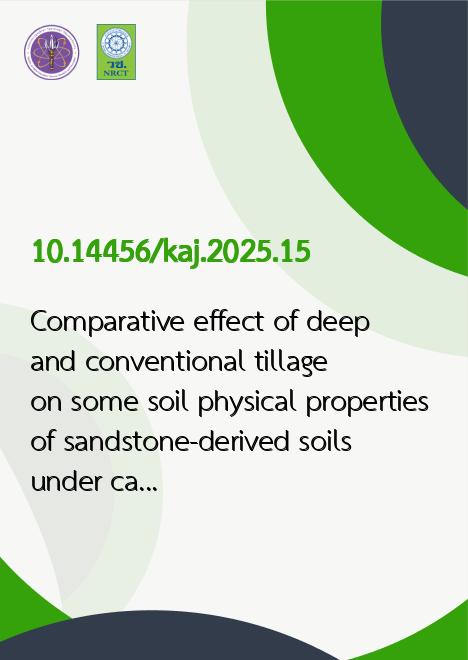
|
Comparative effect of deep and conventional tillage on some soil physical properties of sandstone-derived soils under cassava cultivation |
|---|---|
| รหัสดีโอไอ | |
| Creator | Somchai Anusontpornperm |
| Title | Comparative effect of deep and conventional tillage on some soil physical properties of sandstone-derived soils under cassava cultivation |
| Contributor | Thidaphon Chumsena, Suphicha Thanachit |
| Publisher | Faculty of Agriculture |
| Publication Year | 2568 |
| Journal Title | Khon Kaen Agriculture Journal |
| Journal Vol. | 53 |
| Journal No. | 1 |
| Page no. | 192-209 |
| Keyword | sandy soil, plough pan, deep tillage, soil physical property, cassava |
| URL Website | https://li01.tci-thaijo.org/index.php/agkasetkaj |
| Website title | Khon Kaen Agriculture Journal |
| ISSN | 3027-6497 (Online) |
| Abstract | Plough pan is a major problem for cassava cultivation in upland soils of northeast Thailand. This study was undertaken with the aim of comparing the impact between deep tillage, continuously operated for ten years and conventional tillage, commonly practiced by local farmers on some physical properties of soils derived from sandstone used for cassava cultivation. There were two transects chosen, deep-tilled and conventional-tilled transects. On each transect, five mini soil profiles with the size of 1 x 1 m deep and wide were dug parallelly between two transects. Pedon analysis and field morphology were studied at the time of sampling. Soil samples were collected from genetic horizons for the analysis of particle size distribution, including sand fractions, bulk density, and hydraulic conductivity. All soils were dominated by sand particles, mainly having sand to loamy sand texture. The genetic horizon sequence of all soils was Ap-Bt. The approximate topsoil thickness of deep-tilled soils, on average, was 41.2 cm (mostly Ap1-Ap2) while the conventional-tilled soils had 25.2 cm thick topsoil (mostly Ap). The plough pans with the average bulk density of 1.85 Mg/m3 were found directly underneath the surface layer of all conventional-tilled soils. In contrast, the soils experienced deep-tilled operation showed no sign of subsoil compaction as the layer underneath the surface one had the average bulk density of only 1.55 Mg/m3 which was lower than the directly upper and lower horizons. It was also the case for hydraulic conductivity, but the values were in reverse fashion. The higher bulk density was governed by silt and clay contents while fine and very fine sand contents negatively correlated with bulk density in a significant manner. These evidently reaffirm that continuous deep tillage operation can solve the plough pan problems in these soils and should be recommended to local farmers to operate likewise. |
